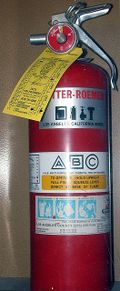Fire extinguisher
Fire extinguishers are important to have in every building. They are an easy way to protect substances from a fire. There are different types of fire extinguishers for different types of fires. These fires require different types of extinguishers to extinguish them. With each type of extinguisher there are a variety of chemical reactions.
History
The first fire extinguisher patented was in 1723 by Ambrose Godfrey from England. Fire extinguishing liquid and gunpowder were the two ingredients in the extinguisher. George William Manby came to be the father of the modern fire extinguisher. These consisted of a copper vessel holding 3 gallons of potassium carbonate (at that time known as pearl ash) in compressed air. The carbon dioxide extinguisher was invented by Walter Kidde Company in 1924 in the USA.[1] The soda-acid extinguishers used sodium bicarbonate solution and sulfuric acid to launch water from inside the container onto the fire. A vial of concentrated sulfuric acid was held inside a cylinder. There were two methods of breaking this vial and thus creating a reaction. The first was to take a plunger to break the vial of acid. The second was to release a lead stopper that held the vial closed. Once the two chemicals mixed carbon dioxide gas was released and then would pressurize the water. The water thereby would be forced out of the container and out through a nozzle or a short hose.[2]
Chemical Reaction
Dry chemical extinguishers spray a mixture of sodium bicarbonate (NaHCO3, baking soda), potassium bicarbonate (KHCO3), or monoammonium phosphate ((NH4)H2PO4).[3] These chemicals, when sprayed, are used to smother the flame. Carbon dioxide (CO2) is used in a type of extinguisher called a carbon dioxide extinguisher. These have highly compressed carbon dioxide in them. It can get to the extent where dry ice may come out of the nozzle because of the high pressure. CO2 extinguisher are not recommended for class A fires.[4] Class A fires involve paper, paper, or anything that leaves ashes. Water is the best way to extinguish an A class fire. Bromochlorodifluoromethane (CF2ClBr) was very common and popular chemical use in extinguishers but designated illegal. This is because the bromine and chloride atoms in chemical were discovered to deplete the ozone in a catalytic cycle.[5]
Classes
There are 5 different classes of fire extinguishers; each are designed for a different purpose. The classes are as follows: A, B, C, D, and K. On each canister, there is a letter and a colored shape identifying each class (see picture at right). Class A extinguishers are made to put out wood, paper, cardboard, and most plastics. Class A has an A in a green triangle. Class B is used for fires involving flammable or combustible liquids for example gasoline, oil, grease, and kerosene. This class has a B in a red square. Class C is made to put out electrical fires and is represented by C in a blue circle. Class D extinguishers are used for chemical laboratories, for when combustible metals like magnesium or potassium are involved in a fire. Class D is shown with D in a yellow star. Class K is made for fires with cooking oil, trans-fats, or fats dealing with cooking appliances. Class K extinguishers are typically found in restaurants and cafeterias. This class is represented by a K in a black or gray hexagon.[6] The most common combination of classes in a fire extinguishers are ABC. The average fire extinguisher is an ABC extinguisher. There are different combinations like BC and AB. Look on the side of the fire extinguisher canister to identify what class it is. BC extinguishers are a dry chemical extinguisher that is filled with sodium bicarbonate or potassium bicarbonate. It leaves a mildly corrosive residue which must be cleaned immediately to protect any damage to any materials. ABC fire extinguishers are also a dry chemical extinguisher. It is filled with monoammonium phosphate (a yellow powder that leaves a sticky residue) that may be damaging to electrical appliances.
How to use
To help people to remember how to operate a fire extinguisher the acronym PASS is used. P stands for pull the pin which is the safety device. A represents aim at the base of the fire to smother the fuel of the fire. S for squeeze the handle to release the fire extinguishing liquid. The last S is for sweep from side to side at the base of the fire. It is commonly heard pull, aim, squeeze,and sweep safety as a key when dealing with fires. [4]
References
- ↑ History of the Fire ExtinguisherAtwood Security. Web. Date of Access 3/26/14
- ↑ Long, Merritt. History of the Fire Extinguisher Firefighting .Web. Date of publication 24/12/07
- ↑ How Dry Chemical Fire Extinguishers WorkHow Stuff Works .Web. date of access 4/15/14
- ↑ 4.0 4.1 Abc's of Fire Extinguishers Emergency Management.Web. date of access 4/14/14
- ↑ Grosshandler, William. Chemicals are used in Fire Extinguisher Scientific American. Web. Date of publication 4/5/99.
- ↑ Fire Extinguisher TypesFire Extinguisher 101. Web. Date of Access 3/26/14
| ||||||||||||||


